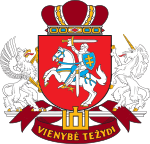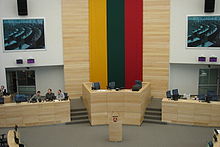Seimas
| logo | Parliament building |
|---|---|

|

|
| Basic data | |
| Seat: | Vilnius |
| Legislative period : | 4 years |
| MPs: | 141 |
| Current legislative period | |
| Last choice: | October 9 and 23, 2016 |
| Chair: | Viktoras Pranckietis ( LVŽS ) |
| Distribution of seats: |
Government (69)
|
| Website | |
| www.lrs.lt | |
The Seimas of the Republic of Lithuania ( Lithuanian Lietuvos Respublikos Seimas ) is the parliament of Lithuania . Lithuania has a unicameral system . The name is derived from the Polish " Sejm " and comes from the time of the Polish-Lithuanian Rzeczpospolita . He designated the highest legislative body of the Grand Duchy of Lithuania .
choice
The legislative period is four years, Lithuanian citizens who are 25 years of age or older, do not serve a sentence and are not bound to another state by oath or promise (Art. 54 and 55, lit. Constitution) have the right to vote . 71 of the seats are assigned as direct mandates through election in constituencies , the remaining 70 to the best ranked candidates on the parties ' lists of nominations , according to their nationwide proportional share of the votes cast. There is a five percent hurdle , list connections must achieve 7% in order to be represented in the Seimas.
job
The constitution defines a spring and an autumn session, which last from March 10th to June 30th and from September 10th to December 23rd (Art. 64, lit. Constitution). These session periods can be extended if necessary (as happened in the case of the impeachment proceedings against President Rolandas Paksas ). In addition, extraordinary meetings can be called; the chairman of the Seimas and the state president have the right to do so.
tasks
The tasks of the Seimas are:
- Consultation and resolution of constitutional amendments (3/5 majority of all MPs) and laws (simple majority of all MPs present)
- Adoption and control of the state budget
- Government control
- Scheduling of referendums
- Scheduling presidential and local elections
- Confirmation of the candidate proposed by the President for the post of Prime Minister
- Confirmation of the government program presented by the Prime Minister
- Formation and organization of government institutions
- Appointment of the highest judges, the chief auditor and the chairman of the National Bank, as well as all heads of state institutions
composition
The Seimas has (again) consisted of a chamber with 141 members since 1992. The last parliament elected on October 9 and 23, 2016 is currently composed as follows:
| Composition of the 12th Seimas | ||||
|---|---|---|---|---|
| fraction | Alignment | Chair | Seats | |
|
Frakcija "Tvarka ir teisingumas (Suvereni Lietuva)" (TTF) Fraction "Order and Justice (Sovereign Lithuania)" |
national conservative | Vytautas Kamblevičius | 7th | |
|
Liberalų sąjūdžio frakcija (LSF) Group of the Liberal Movement |
liberal | Viktorija Čmilytė-Nielsen | 10 | |
|
Lietuvos lenkų rinkimų akcijos - Krikščioniškų šeimų sąjungos frakcija (LLRA-KŠSF) Group of the Electoral Action of Poles of Lithuania - Union of Christian Families |
social - conservative | Rita Tamašunienė | 8th | |
|
Lietuvos socialdemokratų darbo frakcija (LSDDF) Group of the social democratic work of Lithuania |
social democratic | Andrius Palionis | 11 | |
|
Lietuvos socialdemokratų partijos frakcija (LSDPF) Group of the Social Democratic Party of Lithuania |
social democratic | Julius Sabatauskas | 8th | |
|
Lietuvos valstiečių ir žaliųjų sąjungos frakcija (LVŽSF) Group of the Federation of Peasants and Greens of Lithuania |
green , agricultural | Ramūnas Karbauskis | 48 + 1 * | |
| Mišri Seimo narių grupė (MG) Mixed group of Seimas MPs |
- | Rimas Andrikis | 10 | |
|
Tėvynės sąjungos - Lietuvos krikščionių Demokratieų frakcija (TS-LKDF) Group of the Fatherland League - Christian Democrats of Lithuania |
conservative | Gabrielius Landsbergis | 35 | |
| total | 138 ** | |||
history
Constituent Assembly 1920–1922
The first parliament of the Republic of Lithuania was elected as a constituent assembly in April 1920 by free and equal elections. Both men and women were entitled to vote. They elected 149 representatives, with the Christian Democrats making up the largest parliamentary group with 59 seats, ahead of the Peasant Party with 28 seats. The constituent assembly met for the first time on May 15, 1920 in Kaunas . The actual capital Vilnius was occupied by the Poles at that time. The assembly elected Aleksandras Stulginskis as the first chairman .
The most important pieces of legislation were the declaration of the restoration of Lithuania's independence on May 15, 1920, the adoption of the land reform on April 3, 1922, the adoption of the constitution of the Republic of Lithuania (August 1, 1922) and the introduction of its own national currency, the litas , in 1922. During his tenure up to October 1922, the Constituent Assembly passed a total of about 150 laws.
Seimas 1922-1926
On October 11th and 16th, 1922, the first Seimas of independent Lithuania was elected. The legal basis was the constitution of August 1, 1922. Men and women with a minimum age of 24 had the right to vote. The 78 members were elected in 6 constituencies ( Marijampolė , Kaunas , Raseiniai , Telšiai , Panevėžys and Utena ).
After the government failed to find a majority in parliament, new elections were scheduled for May 12 and 13, 1923. Until the next regular elections in May 1926, the right-wing parties (Christian Democrats, Peasant Party) ruled Lithuania with a relatively stable majority in parliament.
Authoritarian government and dissolution of the Seimas 1926–1936
For the elections to the III. Seimas on 8. – 10. May 1926 a seventh constituency "Memel" was formed due to the annexation of the Memelland . The number of MPs also rose to 85.
The elections in May 1926 brought a left-of-center majority with the participation of the Social Democrats and numerous legislative changes (abolition of censorship, abolition of martial law, legalization of the Communist Party) that were a thorn in the side of national conservative circles. In a coup, representatives of the conservative parties appointed a new president, Antanas Smetona, and formed a new government. When the Seimas expressed his distrust of this government, President Smetona postponed parliament on December 17, 1926 and dissolved it on April 12, 1927 - without calling for new elections, as the constitution would have required.
Marionette “Parliaments” 1936–1940
Until 1936 Smetona ruled with the elimination of parliament and the elections on June 9 and 10, 1936 were not free elections, as only one candidate was nominated per constituency (the constituencies now corresponded to the administrative districts) who had previously been nominated by the district administrations had been. In total, this Seimas consisted of only 49 members. They only had the right to vote on constitutional amendments (such as the new constitution of 1938), legislation, ratification of international treaties and budgeting were in the hands of President Smetona.
This Seimas was disbanded by the Soviet occupying power on June 27, 1940. Instead, it called elections for a so-called "People's Seimas". Its members could not be freely elected, but had been nominated as sole candidates as in 1936 before. The primary task of this body was the “accession” of Lithuania to the Soviet Union in August 1940. Subsequently, the “People's Seimas” was converted to the Supreme Soviet of the Socialist Republic of Lithuania .
Supreme Soviet (Restituting Seimas) 1990–1992
For the first time, parties other than the Communist Party of Lithuania were allowed to participate in the regular elections to the Supreme Soviet in 1990. The independence movement " Sąjūdis " won 96 of the total of 141 seats in the free and fair elections in February 1990. At the first meeting on March 11, 1990, the Supreme Soviet passed the declaration with 124 votes in favor, 6 abstentions and no dissenting, the declaration that Lithuania would be independent again, that the constitution of 1938 as the only constitution valid on the territory of Lithuania was again in force and that the Supreme Authority Soviet is the sovereign organ of Lithuanian state power. The leader of the Sąjūdis, Vytautas Landsbergis , who was elected chairman of the parliament on the same day , was declared the new head of state.
On this basis, the Law on the Government of Lithuania was passed on March 22, 1990, whereupon a new Government of Lithuania was appointed on March 24, 1990 under Prime Minister Kazimiera Prunskienė . Until the end of his term of office, the priority work of the Supreme Council - Restituting Seimas, as it was now called, was the drafting of a new constitution, which was passed on October 25, 1992, and a code of the Republic of Lithuania, which was adopted on November 6, 1992 was adopted.
Seimas 1992 to date
After the Supreme Soviet had passed the new electoral law in July 1992, the first parliamentary elections were held in October / November 1992 in the again independent Lithuania. Since then, the Seimas has brought six regular terms to an end. Premature new elections could be avoided if the majority structure changed several times during a legislative period.
Seimas office
The Office of the Seimas of the Republic of Lithuania as a state institution serves the Lithuanian Parliament. It has 1,243 employees.
management
| houses of Parliament | Period | Chairperson | prime minister |
|---|---|---|---|
| Restituting Seimas | 1990-1992 | Vytautas Landsbergis | Kazimira Prunskienė |
| Albertas Šimėnas | |||
| Gediminas Vagnorius | |||
| Aleksandras Abišala | |||
| 6. Seimas | 1992-1996 | Algirdas Brazauskas | |
| Bronislovas Lubys | |||
| Česlovas Juršėnas | |||
| Adolfas Šleževičius | |||
| Laurynas Stankevičius | |||
| 7. Seimas | 1996-2000 | Vytautas Landsbergis | Gediminas Vagnorius |
| Rolandas Paksas | |||
| Andrius Kubilius | |||
| 8. Seimas | 2000-2004 | Artūras Paulauskas | Rolandas Paksas |
| Algirdas Brazauskas | |||
| 9. Seimas | 2004-2008 | ||
| Viktoras Muntianas | |||
| Gediminas Kirkilas | |||
| Česlovas Juršėnas | |||
| 10. Seimas | 2008–2012 | Arūnas Valinskas | Andrius Kubilius |
| Irena Degutienė | |||
| 11. Seimas | 2012-2016 | Vydas Gedvilas | Algirdas Butkevičius |
| Loreta Graužinienė | |||
| 12. Seimas | 2016-2020 | Viktoras Pranckietis | Saulius Skvernelis |
Retirees
As oldest member chaired the first Seimas sessions:
- 1992: Juozas Bulavas (1909–1995), 83 years
- 1996: Jonas Avyžius (1922–1999), 74 years old
- 2000: Kazys Bobelis (1923–2013), 77 years
- 2004: Kazys Bobelis, 81 years old
- 2008: Vida Marija Čigriejienė (* 1936), 72 years
- 2012: Vida Marija Čigriejienė, 76 years old
- 2016: Juozas Imbrasas (* 1941), 75 years
Opposition leader
- 2005, 2012: Andrius Kubilius
- 2010: Vytautas Gapšys
- Algirdas Butkevičius
- 2016–2019: Gabrielius Landsbergis
- since 2019: Viktorija Čmilytė
Seimas members
literature
- Mads Ole Balling: From Reval to Bucharest - Statistical-Biographical Handbook of the Parliamentarians of the German Minorities in East Central and Southeast Europe 1919-1945 . 2nd Edition. 1st volume. Copenhagen 1991, ISBN 87-983829-3-4 , pp. 157 .
Web links
- Official website (lt / en / de / fr / zh)
Individual evidence
- ^ Constitution of the Republic of Lithuania of October 25, 1992 , Section V (= Articles 55 to 76)
- ↑ Article 55 of the Constitution
- ↑ a b lrs.lt
- ↑ Current composition Official website of the Seimas (Lithuanian)
- ↑ History of the Seimas, official website , last accessed on March 5, 2010



